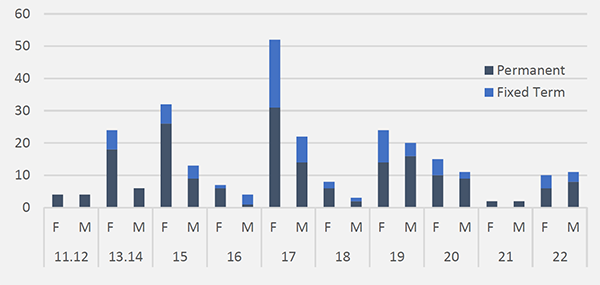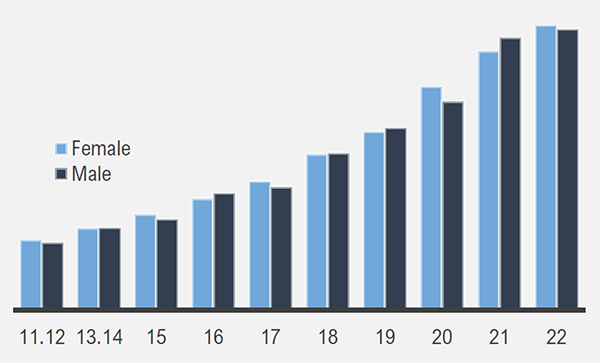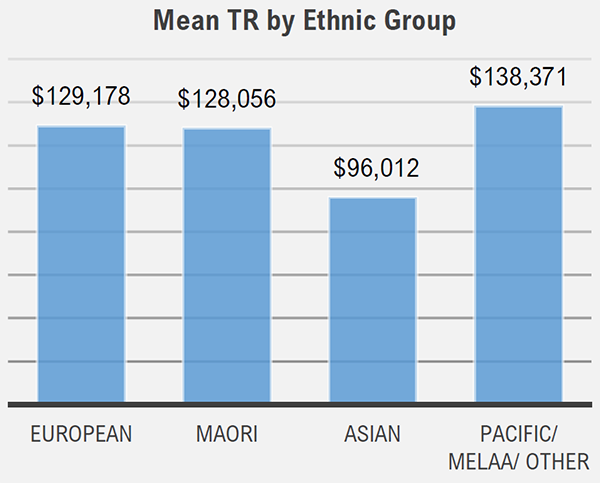Integrating diversity and inclusion is a key ingredient for our organisational success - it helps DPMC improve our services to the government and people of New Zealand, and to attract and retain talented employees.
Formats
DPMC 2023 Kia Toipoto Action Plan#
Integrating diversity and inclusion is a key ingredient for our organisational success – it helps DPMC improve our services to the government and people of New Zealand, and to attract and retain talented employees.
Context#
- DPMC is a small to medium organisation (351 headcount at June 2022 – 199 permanent, 80 fixed term [FT], 72 secondees in) supporting the Prime Minister, the Governor-General and Cabinet as well as the work of our other portfolio ministers.
- There has been unprecedented short term growth through the Covid Response and Health Transition which will have wound back down in 2023. The impact on our statistics of these two groups has been significant.
- We experienced significant fluctuation of staff, due to new business groups standing up and winding down
- GPG June 2020: 19.5%
- GPG June 2021: 14.6%
- GPG June 2022: 12.7% | Sep 2022: 10.4%
- The rapid changes in staffing can cause gender pay data volatility, exacerbated by the impact of FT staff moving in and out (approximately 25% of the staff hired in 2021/22 had already left the organisation by 30 June 2022).
- Change is a constant for DPMC and its operating model has been refined to use ‘docking in’ and ‘docking out’ processes to respond to flex with Government requirements.
- During 2021/22 we had a large number of senior level female secondees whose salaries do not count in our GPG. This has had an impact on our data.
- For this report we have separated permanent and FT data and, outside of remuneration and recruitment, focused our plan on actions for the retention and development of our permanent staff.
What does our data tell us?#
- Our gender pay gap has improved (down 1.9%) compared to last year due to the increase of women represented in higher grade roles – many FT.
- DPMC’s unadjusted pay gap is driven by the over-representation of women in lower pay grades.
- The ‘horizontal’ GPG for permanent staff, within grades and occupational groups, is consistently a positive GPG or below 1.4% (with differences explainable). Only one grade has GPG just above 5%.
- The rapid fluctuation of staff (mostly FT): with 142 employees onboarded and 131 offboarded in the 12 months to 30 June 2022, caused our GPG to move around.
- GPG for permanent new starters increased – from 10% to 21% - although there were more women recruited into the higher grades in 2021/22, this was countered by the high number of women engaged in the lower grades (in particular 13.14,15 and 17). This bodes well for a strong pipe line, however negatively impacts the GPG.
- Increased diversity in target areas through more diversity in new staff appointments. We have used new channels, support and tools to support more diverse appointment processes and outcomes.
Note: This is the second year DPMC and NEMA data is reported separately.
DPMC Data Summary as at 30 June 2022#
- GPG Mean: 12.7%
- GPG Median: 7.7%
DPMC Demographics#

GPG by employee type#
| Employee Type | Mean Total REM | ||
|---|---|---|---|
| Female $ | Male $ | % Gap | |
| Permanent | 117,708 | 140,880 | 16.4% |
| Fixed Term | 127,045 | 130,410 | 2.6% |
| Total | 120,736 | 138,316 | 12.7% |
Mean total remuneration by pay grade#
Of the 10 pay bands below Tier 2 (T2) roles, 6 have a GPG positive to women and 3 have a GPG of 1.4%, with one just over of 5%.

Gender balanced leadership#
Women occupied 62% of all people leader roles (43 of 73) and 57% of T2 and T3 roles.

Ethnicity#
DPMC continues to focus on improving our ethnicity profile. Improving ethnic representation in our workforce and in leadership has been a focus in recent years and will continue to be so. Attracting appropriate candidates and growing the skillsets internally will be key to making this shift.
While attraction of ethnically diverse applicants has been successful, our data shows that this does not always flow through to hire. There are questions as to whether we are attracting appropriate applicants or whether there are biases in the recruitment processes. Understanding this, and working to address, will be an area of focus in 2023.
Candidate Ethnicity – 12 months to June 2022#
| Applications | Shortlisted | Interview | Offered | Hired | |
|---|---|---|---|---|---|
| NZ European | 63% | 76% | 76% | 83% | 84% |
| Asian | 20% | 9% | 8% | 6% | 5% |
| Pacific | 4% | 3% | 3% | 3% | 3% |
| Māori | 7% | 9% | 10% | 6% | 5% |
| MELAA* | 6% | 3% | 3% | 3% | 3% |
Average pay by ethnicity#
The ethnic groups other than European have smaller identified numbers with several senior roles impacting on the average remuneration, this is the case for Pacific, MELAA* and Other. Asian and Māori are similar size. More employees identifying as Asian are in the lower and middle grades, with no leaders identifying as Asian.

Non-European ethnic groups have a low representation in DPMC with average salaries for some ethnic groups being less than others. The numbers are too small to create robust measures of ethnic pay gaps for each group. We have instead calculated a pay gap between all Māori, Pacific, Asian and MELAA employees and European employees, which sits at 8%. This is largely driven by grade distribution, with only a small number of our ethnic employees being in higher grades.
Of note, people leaders identifying with ethnicities other than European are proportionately less than their representation in the workforce. This will be an area of focus over the next few plans.
*MELAA: Middle Eastern, Latin American and African.
Focus areas: achievements and plans for 2023#
Our Kia Toipoto work is focused on what is required for DPMC to close its ethnic and gender pay gaps. It also aligns with the broader requirements for all agencies set out by Te Kawa Mataaho, Public Service Commission. This plan should be read in conjunction with our Diversity and Inclusion Action Plan, our Whāinga Amorangi Plan, and our Te Reo Māori Plan.
| Focus area | Increase ethnic representation across our workforce, and in leadership roles. |
|---|---|
| Achieved in 2022 |
Ongoing promotion and embedding of:
|
| Planned in 2023 |
|
| Focus area | Increase the representation of women and ethnic employees in higher pay grades and in areas of the business in which they are under-represented through a focus on attraction, recruitment and progression. |
|---|---|
| Achieved in 2022 |
Ongoing promotion and embedding of:
|
| Planned in 2023 |
Ongoing promotion and embedding of:
|
| Focus area | Pay gap in our permanent staff |
|---|---|
| Achieved in 2022 |
|
| Planned in 2023 |
|
| Issue | Part time staff engagement – Part-time staff (mostly women) consistently had engagement scores 10% lower than average prior to 2021 |
|---|---|
| 2020/21 Focus area | Engage with part-time staff to understand what would improve the workplace for this group. |
| Achieved in 2022 |
|
| Planned in 2023 |
|
| Issue | Impact of fixed term staff (42% in 2022) on the data is well understood. |
|---|---|
| 2020/21 Focus area | Outside of managing remuneration, it is challenging to develop programmes with a focus on our permanent/future workforce with the data in a single set. |
| Achieved in 2022 |
|
| Planned in 2023 |
|
Public Service Commission Milestones: achievements and plans for 2023#
| Topic | Te whai kanohi i ngā taumata katoa - Leadership and representation |
|---|---|
| Milestone | By the end of April 2023 agencies and entities have plans and targets to improve gender and ethnic representation in their workforce and leadership. |
| Achieved in 2022 |
|
| Planned in 2023 |
|
| Topic | Te Whakawhanaketanga i te Aramahi - Effective career and leadership development |
|---|---|
| Milestone |
|
| Achieved in 2022 |
|
| Planned in 2023 |
|
| Topic | Ngā Hua Tōkeke mō te Utu - Equitable pay outcomes |
|---|---|
| Milestone |
|
| Achieved in 2022 |
|
| Planned in 2023 |
|
| Topic | Te Taunoa o te Mahi Pīngore - Flexible-work-by default |
|---|---|
| Milestone |
|
| Achieved in 2022 |
|
| Planned in 2023 |
|
| Topic | Te whakakore i te katoa o ngā momo whakatoihara, haukume anō hoki - Eliminating all forms of bias and discrimination |
|---|---|
| Milestone |
|
| Achieved in 2022 |
|
| Planned in 2023 |
|
